Educational technology has become a prominent feature of educational institutions at all levels. It is a means of bringing about the desired reform in educational systems and their various components. Its use will play a significant role in bridging the gap between the social and economic reality on the one hand, and the outcomes of education and training systems on the other. This will be achieved by improving educational outcomes and equipping students and trainees with the new knowledge and skills required in the era of the knowledge economy. It will also have a clear impact in expanding learning opportunities for a larger and more diverse population, regardless of time or geographic boundaries.
Therefore, blended learning, which includes an integrated combination of face-to-face and technology-mediated interactions between students, teachers, and learning resources, has rapidly spread among the world's leading higher education institutions and has topped the list of emerging trends in higher education since 2012. Blended learning provides opportunities for higher education institutions to achieve the learning outcomes necessary to meet the needs of a modern, globalized, and technologically driven world. UNESCO emphasizes that blended learning is a valuable approach to help enhance learning and achieve Sustainable Development Goal 4, known as Education 2030, which aims to ensure equitable quality education and lifelong learning opportunities in all forms of formal and non-formal education. The increasing adoption of blended learning within higher education institutions is noticeable, and researchers predict that blended learning will become the "new conventional model" (Ross & Gage, 2006) or the "new normal" in higher education course delivery (Moskal, 2011).
The Saudi Electronic University aims to provide high-quality educational services in a learner-centered environment. Therefore, the university has adopted a flexible blended learning model that meets the needs of learners in the knowledge age. This model utilizes information and communications technology, supports self-directed and collaborative learning, and reduces the isolation learners experience in a distance learning environment. This model combines direct (face-to-face) instruction with online learning, both synchronous and asynchronous, in an integrated model that combines the advantages of each.
Therefore, blended learning has emerged, which includes an integrated mix of direct (face-to-face) interactions and technology-mediated interactions between students, teachers, and learning resources. The blended learning model at Saudi University achieves the ideal balance between direct (face-to-face) activities and online activities, with the aim of providing students with a diverse and integrated educational experience that includes live lectures, synchronous virtual lectures, and synchronous/asynchronous online activities through the educational platform (Blackboard).
1. Supported face-to-face teaching model
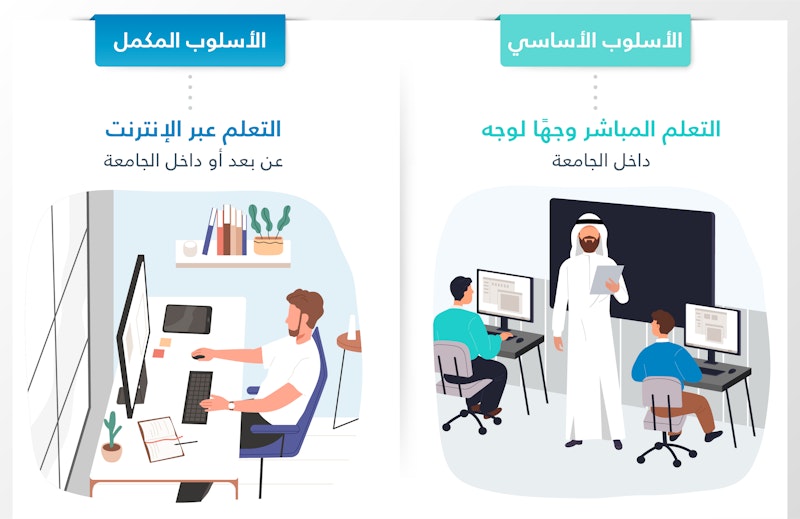
This model is considered the closest to the traditional model and is based on the principle that direct instruction is the primary method. The bulk of the course is delivered through face-to-face lectures, while electronic elements are used in the classroom or remotely when necessary to support students in completing specific tasks.
2. Intensive Virtual Learning Model
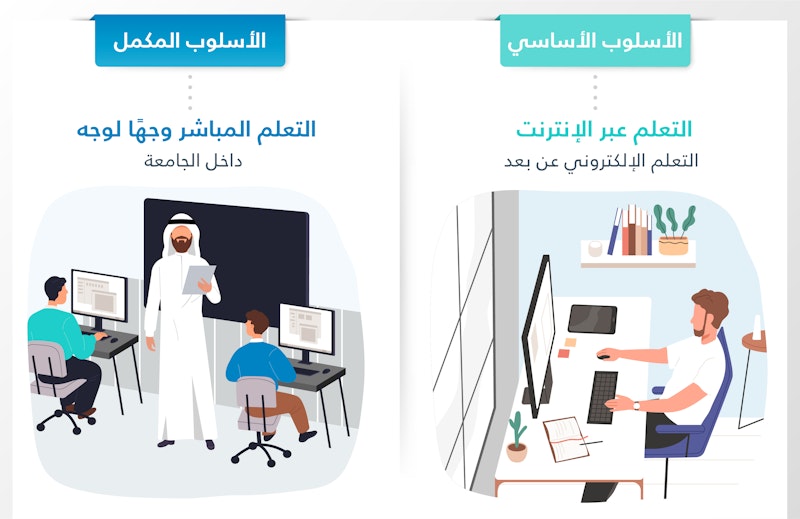
In contrast to the technology-enabled face-to-face model of instruction, virtual distance learning is the foundation of this model. All expected activities take place in an online learning environment. These activities include peer-assisted learning, reading, practical activities, and instructor-guided instruction. Communication and discussion in this model take place via electronic channels. Traditional face-to-face classes are not eliminated in this model; additional lectures/sessions on campus may be used to provide additional support, such as workshops.
3. Flexible model
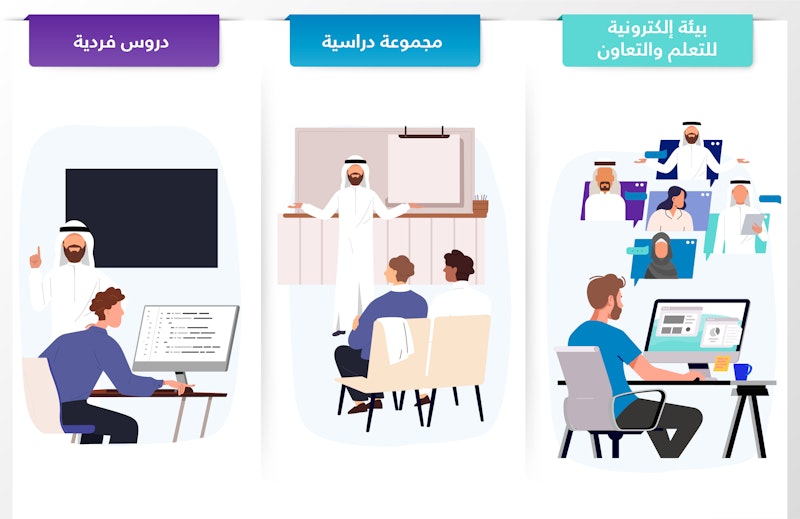
In this model, learning is self-directed by students in an online environment where educational content and activities are delivered. Students in this model have a high degree of control over the learning process, as they can learn at their own pace. Faculty provide on-campus support and guidance, such as small study groups, individual lessons, and other forms of instruction, within a flexible framework that meets students' needs as they progress through the curriculum and learning content.
4. The eclectic model
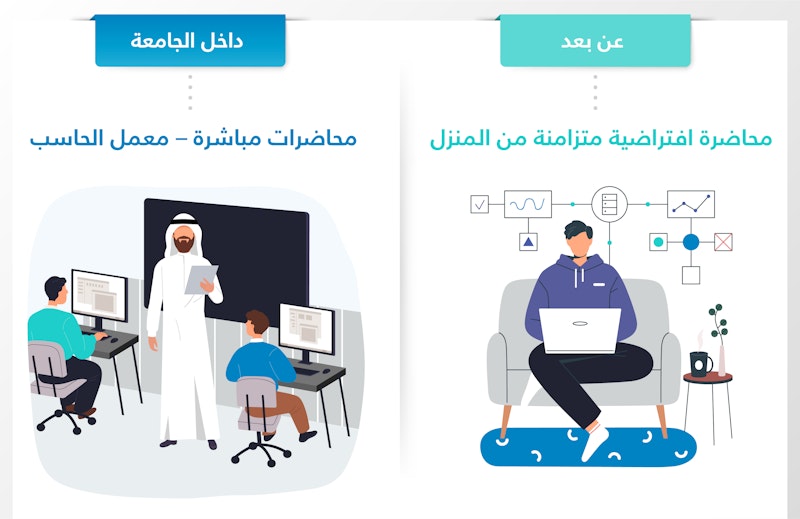
This model allows students to enroll in online courses in addition to traditional on-campus courses, giving students greater flexibility in designing their schedules. The selective model is a suitable option when the university cannot offer certain learning opportunities or elective courses.
5. Alternating model
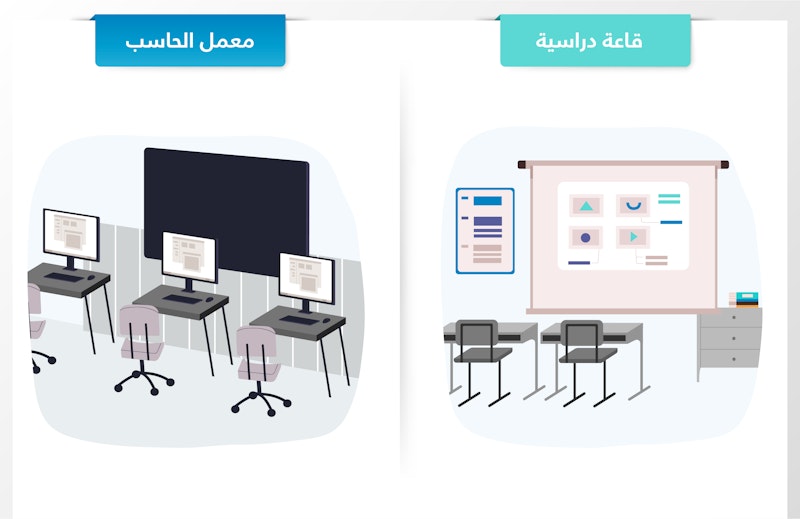
This model enables students to enroll in online courses, in addition to traditional on-campus courses. The alternating model includes a schedule that requires students to alternate learning methods on a regular basis. This may include alternating between face-to-face and online learning. A common feature of this model is regular scheduling, in which both online and face-to-face learning elements are used sequentially, either to reinforce each other or to expand one or both. Several models have emerged from this model:
- Start and end pattern.
- Start Middle End Pattern.
- Flipped classroom model.
- week on/week off pattern.
- Inside-Out Blended Learning Model.
- Outside-In Blended Learning Model.
- Enriching both students' educational experience and learning outcomes.
- Fulfilling students’ aspirations to make optimal use of technology, in addition to developing new skills that qualify them for the job market in the global networked environment.
- Meeting the individual's personal needs, learning style, and schedule
- It stimulates the development of self-learning skills.
- Develops both the skills and knowledge of faculty members in order to transform and develop the teaching process.
- Strengthening the links between the classroom and the real world.
- It enhances the convenience and flexibility of accessing course resources and activities, especially for people who face difficulties related to work, family, or geographical distance.
- It helps reduce the costs of delivering education and make optimal use of physical and virtual resources.
- Increase the level of competition in building a new student market through innovation in the implementation of academic programs.